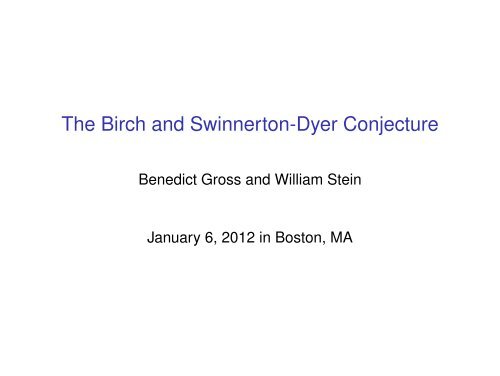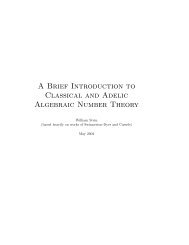The Birch and Swinnerton-Dyer Conjecture, Jan 6 ... - William Stein
The Birch and Swinnerton-Dyer Conjecture, Jan 6 ... - William Stein
The Birch and Swinnerton-Dyer Conjecture, Jan 6 ... - William Stein
You also want an ePaper? Increase the reach of your titles
YUMPU automatically turns print PDFs into web optimized ePapers that Google loves.
<strong>The</strong> <strong>Birch</strong> <strong>and</strong> <strong>Swinnerton</strong>-<strong>Dyer</strong> <strong>Conjecture</strong><br />
Benedict Gross <strong>and</strong> <strong>William</strong> <strong>Stein</strong><br />
<strong>Jan</strong>uary 6, 2012 in Boston, MA
Algebraic equations<br />
c<br />
a 2 +b 2 =c 2<br />
Pythagoras (600 BCE) Baudhāyana (800 BCE)<br />
a<br />
b
Pythagorean triples<br />
a 2 + b 2 = c 2 has solutions (3, 4, 5), (5, 12, 13), (7, 24, 25), . . .<br />
<strong>The</strong>re are more solutions on a Babylonian tablet (1800 BCE):<br />
(3, 4, 5)<br />
(5, 12, 13)<br />
(7, 24, 25)<br />
(9, 40, 41)<br />
(11, 60, 61)<br />
(13, 84, 85)<br />
(15, 8, 17)<br />
(21, 20, 29)<br />
(33, 56, 65)<br />
(35, 12, 37)<br />
(39, 80, 89)<br />
(45, 28, 53)<br />
(55, 48, 73)<br />
(63, 16, 65)<br />
(65, 72, 97)
<strong>The</strong> general solution of a 2 + b 2 = c 2<br />
x = a/c <strong>and</strong> y = b/c satisfy the equation x 2 + y 2 = 1<br />
-1<br />
-0.<br />
(0,t)<br />
0.<br />
5<br />
5 0<br />
-<br />
0<br />
.<br />
5<br />
-1<br />
t = y<br />
1 + x<br />
1<br />
.<br />
5<br />
(x,y)<br />
1<br />
x =<br />
1 − t2<br />
1 + t 2<br />
y = 2t<br />
1 + t 2
Write t = p/q. <strong>The</strong>n<br />
a = q 2 − p 2<br />
x = q2 − p 2<br />
q 2 + p 2<br />
y = 2qp<br />
q 2 + p 2<br />
b = 2qp c = q 2 + p 2<br />
t = 1/2 −→ (a, b, c) = (3, 4, 5)<br />
t = 2/3 −→ (a, b, c) = (5, 12, 13)<br />
t = 3/4 −→ (a, b, c) = (7, 24, 25)
Cubic equations<br />
After linear <strong>and</strong> quadratic equations come cubic equations, like<br />
x 3 + y 3 = 1 y 2 + y = x 3 − x<br />
Here there may be either a finite or an infinite number of<br />
rational solutions.
<strong>The</strong> graph<br />
4<br />
2<br />
0<br />
-2<br />
-4<br />
(−1,0)<br />
y 2 + y = x 3 − x<br />
(0,−1)<br />
(2,−3)<br />
-2 -1 0 1 2 3
<strong>The</strong> limit of a secant line is a tangent<br />
4<br />
2<br />
0<br />
-2<br />
-4<br />
y 2 + y = x 3 − x<br />
<br />
21 56 ,− 25 125<br />
(2,−3)<br />
-2 -1 0 1 2 3
Large solutions<br />
If the number of solutions is infinite, they quickly become large.<br />
y 2 + y = x 3 (0, 0)<br />
(1, 0)<br />
− x<br />
(-1, -1)<br />
(2, -3)<br />
(1/4, -5/8)<br />
(6, 14)<br />
(-5/9, 8/27)<br />
(21/25, -69/125)<br />
(-20/49, -435/343)<br />
(161/16, -2065/64)<br />
(116/529, -3612/12167)<br />
(1357/841, 28888/24389)<br />
(-3741/3481, -43355/205379)<br />
(18526/16641, -2616119/2146689)<br />
(8385/98596, -28076979/30959144)<br />
(480106/4225, 332513754/274625)<br />
(-239785/2337841, 331948240/3574558889)<br />
(12551561/13608721, -8280062505/50202571769)<br />
(-59997896/67387681, -641260644409/553185473329)<br />
(683916417/264517696, -18784454671297/4302115807744)<br />
(1849037896/6941055969, -318128427505160/578280195945297)<br />
(51678803961/12925188721, 10663732503571536/1469451780501769)<br />
(-270896443865/384768368209, 66316334575107447/238670664494938073)
Even the simplest solution can be large (Watkins)<br />
y 2 + y = x 3 − 5115523309x − 140826120488927<br />
Numerator of x-coordinate of smallest solution (5454 digits):<br />
Denominator:
<strong>The</strong> rank<br />
<strong>The</strong> rank of E is essentially the number of independent<br />
solutions.<br />
◮ rank (E) = 0 means there are finitely many solutions.<br />
◮ rank (E) > 0 means there are infinitely many solutions.<br />
◮ <strong>The</strong> curve E(a) with equation<br />
y(y + 1) = x(x − 1)(x + a)<br />
has rank = 0, 1, 2, 3, 4 for a = 0, 1, 2, 4, 16.
<strong>The</strong> rank is finite<br />
Can it be arbitrarily large?
<strong>The</strong> current record is rank(E) ≥ 28<br />
y 2 + xy + y = x 3 − x 2 − 20067762415575526585033208209338542750930230312178956502x+<br />
344816117950305564670329856903907203748559443593191803612660082962919394 48732243429
Peter <strong>Swinnerton</strong>-<strong>Dyer</strong> <strong>and</strong> Bryan <strong>Birch</strong> made a prediction for<br />
the rank, based on the average number of solutions at prime<br />
numbers p.
Primes<br />
A prime p is a number greater than 1 that is not divisible by any<br />
smaller number.<br />
2, 3, 5, 7, 11, 13, 17, 19, 23, 29, 31, 37, 41, 43, 47, 53, 59, 61,<br />
67, 71, 73, 79, 83, 89, 97, 101, 103, 107, 109, . . .<br />
<strong>The</strong>re are infinitely many primes. <strong>The</strong> largest explicit prime<br />
known is 2 43112609 − 1 with 12,978,189 digits.<br />
80<br />
60<br />
40<br />
20<br />
100 200 300 400 500
What do we mean by a solution of the cubic equation at the<br />
prime number p?<br />
y 2 + y = x 3 − x<br />
(x, y) ≡ (3, 1) is a solution at p = 11<br />
<strong>The</strong>re are finitely many solutions A(p) at each prime p.<br />
20<br />
15<br />
10<br />
5<br />
0<br />
0 5 10 15 20<br />
p =23, A(23) =22<br />
70<br />
60<br />
50<br />
40<br />
30<br />
20<br />
10<br />
0<br />
0 10 20 30 40 50 60<br />
p =71, A(71) =63<br />
70
It is common to write<br />
#{solutions mod p} = A(p) = p + 1 − a(p)<br />
We define the L-function of E by the infinite product<br />
L(E, s) = <br />
all p<br />
(1 − a(p)p −s + p 1−2s ) −1 = a(n)n −s<br />
This definition only works in the region s > 3/2, where the<br />
infinite product converges.<br />
1<br />
0.8<br />
0.6<br />
0.4<br />
0.2<br />
0<br />
?<br />
0 2 4 6 8
If we formally set s = 1 in the product, we get<br />
<br />
all p<br />
(1 − a(p)p −1 + p −1 ) −1 = <br />
all p<br />
p<br />
A(p)<br />
If A(p) is large on average compared with p, this will approach<br />
0. <strong>The</strong> larger A(p) is on average, the faster it will tend to 0.<br />
0.7<br />
0.6<br />
0.5<br />
0.4<br />
0.3<br />
0.2<br />
0.1<br />
0<br />
100 200 300 400 500
<strong>The</strong> conjecture of <strong>Birch</strong> <strong>and</strong> <strong>Swinnerton</strong>-<strong>Dyer</strong><br />
1. <strong>The</strong> function L(E, s) has a natural (analytic) continuation to<br />
a neighborhood of s = 1.<br />
2. <strong>The</strong> order of vanishing of L(E, s) at s = 1 is equal to the<br />
rank of E.<br />
3. <strong>The</strong> leading term in the Taylor expansion of L(E, s) at<br />
s = 1 is given by certain arithmetic invariants of E.<br />
L(E, s) = c(E)(s − 1) rank(E) + · · ·
<strong>The</strong> most mysterious arithmetic invariant was studied by John<br />
Tate <strong>and</strong> Igor Shafarevich, who conjectured that it is finite. Tate<br />
called this invariant X.
<strong>The</strong> <strong>Birch</strong> <strong>and</strong> <strong>Swinnerton</strong>-<strong>Dyer</strong> <strong>Conjecture</strong><br />
L(E, s) = c(E)(s − 1) rank(E) + · · ·<br />
c(E) = ΩE · Reg E ·#XE · cp<br />
#E(Q) 2 tor<br />
Each quantity on the right measures the size of an<br />
abelian group attached to E.
Natural (analytic) continuation<br />
<strong>The</strong> infinite sum ∞<br />
n=0 x n converges when −1 < x < 1.<br />
1<br />
1 − x =<br />
∞<br />
n=0<br />
x n<br />
-6 -5 -4 -3 -2 -1 1<br />
7<br />
6<br />
5<br />
4<br />
3<br />
2<br />
1
Fermat’s Last <strong>The</strong>orem<br />
<strong>The</strong> natural (analytic) continuation of L(E, s) = a(n)n −s was<br />
obtained (in most cases) by Andrew Wiles <strong>and</strong> Richard Taylor<br />
(1995). <strong>The</strong>y proved that the function defined by the infinite<br />
series<br />
is a modular form.<br />
F(τ) = a(n)e 2πinτ
Combining a limit formula of Benedict Gross <strong>and</strong> Don Zagier<br />
(1983) with work of Victor Kolyvagin (1986) we can now show<br />
the following.<br />
If L(E, 1) = 0 the rank is zero, so there are finitely many<br />
solutions.<br />
If L(E, 1) = 0 <strong>and</strong> L ′ (E, 1) = 0 the rank is one, so there are<br />
infinitely many solutions.<br />
In both cases, we can also show that X is finite.
Example: A Rank 1 Curve<br />
sage: E = EllipticCurve([0,0,1,-1,0])<br />
sage: L = E.lseries()<br />
sage: Lser = L.taylor_series(); Lser<br />
0.305999773834052*z + 0.186547797268162*zˆ2 + ...<br />
sage: c = Lser[1]; c<br />
0.305999773834052<br />
sage: Omega_E = E.period_lattice().omega(); Omega_E<br />
5.98691729246392<br />
sage: Reg_E = E.regulator(); Reg_E<br />
0.0511114082399688<br />
sage: prod_cp = E.tamagawa_product_bsd(); prod_cp<br />
1<br />
sage: T = E.torsion_order()ˆ2; T<br />
1<br />
sage: c / (Omega_E * Reg_E * prod_cp / Tˆ2)<br />
1.00000000000000
Example: A Rank 2 Curve<br />
sage: E = EllipticCurve([0,1,1,-2,0])<br />
sage: L = E.lseries()<br />
sage: Lser = L.taylor_series(); Lser<br />
-2.69e-23 + (1.52e-23)*z + 0.75931650028*zˆ2 + ...<br />
sage: E.rank()<br />
2<br />
sage: c = Lser[2]<br />
sage: Omega_E = E.period_lattice().omega()<br />
sage: Reg_E = E.regulator()<br />
sage: prod_cp = E.tamagawa_product_bsd()<br />
sage: T = E.torsion_order()ˆ2<br />
sage: c / (Omega_E * Reg_E * prod_cp / Tˆ2)<br />
1.00000000000000<br />
sage: S = E.sha(); S<br />
Tate-Shafarevich group ...<br />
sage: S.p_primary_bound(5)<br />
0<br />
Open Problem: Prove that X(E) is finite.
Example: A Rank 4 Curve<br />
sage: E = EllipticCurve([0,15,1,-16,0])<br />
sage: L = E.lseries()<br />
sage: Lser = L.taylor_series(); Lser<br />
4.32e-24 + (-1.96e-23)*z + (2.05e-22)*zˆ2<br />
+ (-7.97e-22)*zˆ3 + 10.84*zˆ4 - ...<br />
sage: E.rank()<br />
4<br />
sage: c = Lser[4]<br />
sage: Omega_E = E.period_lattice().omega()<br />
sage: Reg_E = E.regulator()<br />
sage: prod_cp = E.tamagawa_product_bsd()<br />
sage: T = E.torsion_order()ˆ2<br />
sage: c / (Omega_E * Reg_E * prod_cp / Tˆ2)<br />
0.99999999999999<br />
Open Problem: Prove that ords=1 L(E, s) = 4.
Thank you
















